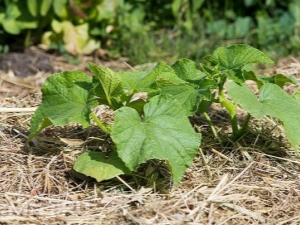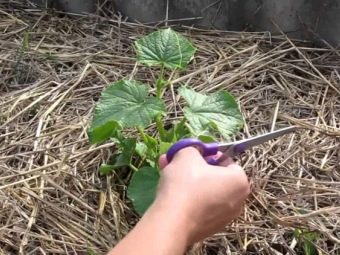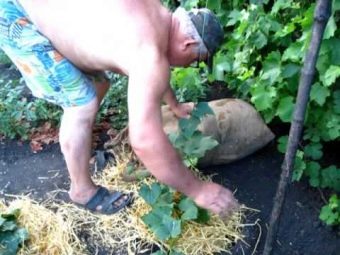Features of mulching of cucumbers in the open ground

Many gardeners are asked topical issues, whether to do the mulching of cucumbers, what is the use of this, how time-consuming and costly this work. Let's take a closer look at this technology.
Characteristics of the procedure
To grow strong and healthy cucumbers in your plot, you need to take care of good watering, the absence of pests / pathogenic bacteria in the root system of plants, as well as to protect them from night temperature differences. It will help to cope with this difficult task very simple technique - mulching. Today we will get acquainted with the features of this process.
Mulching is a covering of the top layer of soil in the beds with materials of natural and artificial origin.
The procedure itself is very simple. Mulch is applied on pre-fertilized and loosened soil, completely covers it, protecting it from the effects of aggressive environment.
This allows:
- retain moisture in the ground;
- prevent soil erosion;
- develop a strong plant root system;
- save nutrients accumulated in the soil;
- to avoid the growth of weeds, as well as to reduce the number of weeds;
- save seedlings from rodents and insects - pests;
- get a richer and earlier harvest.
Some gardeners do not see much point in the use of this agricultural technology. In fact, to neglect such works is not worth it. This method prompted people to nature itself.
Hot summer in the forest is difficult to find young plants, dying from thirst, or tormented by pests. The land covered with fallen leaves, needles, twigs and pieces of bark, is well protected from the scorching sun, as well as the evaporation of precious moisture - it is difficult to reach the roots of plants and dangerous pests.
Mulching is an easy way to protect the soil and to take care of vegetable, berry and flower crops. It helps increase gardeners, yields, saves their time and energy. This procedure should be carried out by those who grow cucumbers in open ground. This is especially beneficial for city dwellers who are not able to come to their site every day to loosen, process the beds from weeds, and also water them abundantly.
Cucumbers love water, so many gardeners install automatic or drip irrigation in their plots, hoping that it will replace their temporary absence. But, unfortunately, it is not always effective. Water can simply nail dust on the ground, but not penetrate to the drying roots. Mulching will solve this problem. It is useful to carry out such an operation in greenhouses made of polyethylene and polycarbonate.
Advantages and disadvantages
The method of mulching has a lot of advantages:
- the land does not crack during a long summer drought;
- there is no crust on the surface after watering;
- free access of air to the root system;
- preservation of nutrients in the soil, obtained by feeding;
- obtaining additional nutrition in the formation of humus during the decomposition of organic mulch;
- soil temperature stabilization;
- lowering the overall level of humidity in greenhouses;
- Mulching is carried out 1 time per summer, then only supplemented with fresh material;
- cucumbers will be clean - dirt and dust will not rise from the ground to the fruit;
If we talk about the shortcomings of agricultural engineering, they are much smaller.
- It is not recommended to make a layer of mulching more than 2 cm, if using clay soils (more viscous and heavy). Organic mulch will begin to rot, contributing to plant disease. This also applies to vegetable gardens located in the vicinity of groundwater.
- It is dangerous to use freshly cut grass as mulch. It complicates the access of fresh air to the roots, which is especially important for cucumbers. Attracts worms and slugs that can harm plants.
- Dry wild herbs for mulch can also have dubious benefits, as they can contain seeds that can quickly germinate and then interfere with the free growth of lashes.
- Organic mulch from grass, beginning to quickly sweep, creates an excellent environment for the habitat of various beetles and larvae, for which birds flock to the beds. It is possible that feathered hunters eat not only the worms, but also your cucumbers.
- Field mice and hamsters can settle in the straw / grass in the garden.
- In case of inorganic mulching, such materials as film, expanded clay, gravel make it difficult to apply fertilizer, as well as to carry out cleaning work on the site.
When to do?
With the arrival of the long-awaited heat, it is time to plant cucumbers, as well as to mulch.
Cucumbers love the heat, as well as the soil well warmed by the sun. If a cold snap is not expected, the air temperature reaches up to 25 degrees during the day, and during the night does not fall below 16 degrees, vegetable seedlings are planted in open ground and mulched. In the regions of our country, favorable conditions for planting / mulching procedures occur at different times. It depends on the climatic conditions.
- In areas with a warm climate, the best time for mulching is mid-May.
- The first days of June - the time of mulching in the Middle and Central Black Earth region of Russia
- The first decade of June - in all regions of the country.
When planting seeds in open ground mulch the soil when the first 3 true leaves appear. Cucumbers are sown directly into the ground 2-3 weeks earlier than the seedlings are planted, so the time for mulching of cucumber seedlings as well as the mulching of seedlings practically coincides.
In greenhouses made of polycarbonate at a temperature of +20 degrees, the procedure is carried out earlier.
- Warm regions - the last decade of April.
- In the center of Russia - the middle of May, or the first days of June.
- Siberia, the Urals, the Volga region - the last days of May.
If you are going to do mulching, rely not only on general information about the timing of the procedure, but also act according to circumstances. Watch the weather, air temperature. Inspect the soil (see how warm and humid it is).
Ways
In the open ground
Before planting the seedlings and mulch the soil, all weeds are predusted.
- Mulch is applied around cucumbers and between the rows.
- Do not put mulch under the stems - it can damage the whips, cause various diseases.
- The lower layer quickly rotts, therefore, to replace organic mulch / to supplement it with fresh multilide, the entire period of growth and maturation of the culture is necessary.
- When mulching cucumbers in any inorganic way, you must first make a dry top dressing for plants of prolonged action.
- Watering with the addition of liquid fertilizer can all season directly from the watering can on top of the mulch.
Indoor
Mulching of cucumbers in the greenhouse is carried out in the same way as in the open air - when it becomes warm and the soil is completely warm.
- Land on the beds neatly level, make wide aisles.
- Make the selected mulch to the surface
- A layer in the greenhouse is desirable no more than 2-5 cm,
- Change the mulch on demand, as soon as the bottom layer rot. To see when this happens, the reservoir periodically rises in some places. This is how the presence of unwelcome residents - beetles, lizards, snails - is checked.
- In artificial mulch, they pre-make holes for seedlings.
- First, plant material on the beds, and then plants are planted in the holes.
- In polycarbonate greenhouses, it is better to use organic mulch, natural burlap, a thin layer of straw or peat mixture.
- From the use of black film, attracting the sun's rays in the heat, it is better to refuse.
Acquainted with the variety of methods and materials, you can easily determine which means of mulching suitable for your site or greenhouse.
- Well rotted compost.
- Sawdust with nitrogen fertilizer.
- Rotten cow dung.
- Husk from seeds, pine nuts.
Nettle
Nettle mulching is one of the easiest and most economical ways. You can find nettles at each summer cottage, so there will be no problems with raw materials. The protective layer of these plants not only performs its main task - it saves the beds from moisture loss and temperature difference, but also copes with other problems.
- Fertilizes the land.
- Prevents weeds from germinating.
- It does not give the opportunity to live on the beds of slugs and snails.
- Promotes reproduction under its cover of beneficial inhabitants, loosening the soil, forming humus.
- Fights the emergence of dangerous aphids on cucumbers
It is easy to prepare nettle mulch. Seed nettles without seeds must be dried, crushed using a thresher or simply by hand. The finished mulch must be laid out in a layer up to 4 cm. On the beds around the plants, without touching the stems.
To the plant was not burning, you can mix it with wood ash. It is practiced to add ashes prepared from nettle into the mulch. It contains potash, a salt of potassium carbonate. This is an excellent natural plant food that does not contain chlorine.
Nettle is rich in various valuable microelements and vitamins. It contains iron, nitrogen, necessary for plants. Some gardeners bury it in the beds shortly before planting cucumber seedlings, carrying out mulching to further enrich the soil.
Among the many advantages of this method, there is only one drawback - nettles quickly overheat in the summer sun. It is necessary to add a new layer of mulch twice, or even three times in a month.
During wet weather, gray mold can appear on a thick layer of nettle. This happens if the cover of the mulch is too thick and the plants are chopped too coarsely. Such a layer must be removed and not be too lazy to put a new, finely chopped mulch.
Thatch
Straw mulching can be used both in the open field and in the greenhouse. Like nettles, straw is better to cut into mulch. Before use, nitrogen fertilizers must be applied to the beds.
Straw is the only mulch that is applied to the soil with a thick layer up to 10 cm, as it is quite airy. After some time after placement on the beds, the layer will drop and become much thinner.
- During the procedure, do not scatter the straw in piles, large armfuls. Lay it evenly strands.
- A very thick layer should not be applied - under a large cover, pathogenic bacteria that are harmful to plants can form.
- To avoid problems, straw can be pre-sanitized, soaked in a weak solution of potassium permanganate, and then dried in the sun.
- You can do straw mulching in combination with compost or rotted manure.
- It is advisable to mix with urea before use in the proportion of 200 g of fertilizer per 10 kg. straw
For mulching cucumbers fit any straw. Gather it in advance at the end of the summer (after harvesting cereals). Since the mulching of cucumbers will be carried out only next summer, straw needs to be prepared for future use.
- Spread raw material in a thin layer in the sun.
- Dry, periodically turning the fork.
- Dried mulch collected in bags, and then sent to storage in a well-ventilated room.
Straw mulch contributes to:
- conservation of soil fertility, its saturation with vitamins and microelements;
- protection of young plants from overheating and cooling;
- maintaining the required level of soil moisture;
- increase yields.
Tips
Consider some helpful tips related to cucumber mulching.
- When growing cucumbers in a greenhouse made of polycarbonate, remember that in hot weather, when it is more than 30 degrees outside, the temperature inside is 2 times higher. Do not forget to open the windows and air it.
- To avoid overheating, buy a white non-woven fabric in any garden center, and then cover it with a greenhouse on top.
- If you still use black tape, cover the top of the dark cover white material in the heat. This will save cucumbers from overheating.
With any method of mulching, remember that the covering layer of the material is not placed close to the very stem of the plant in order to avoid fatal diseases.
On the mulching and cultivation of cucumbers in the greenhouse and in the open field, see the following video.









































